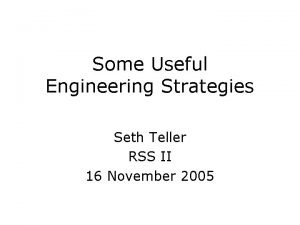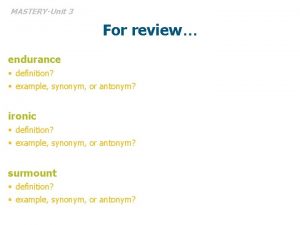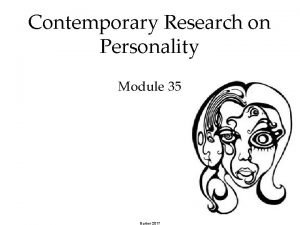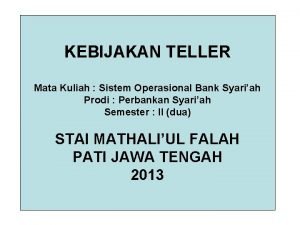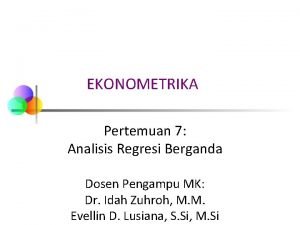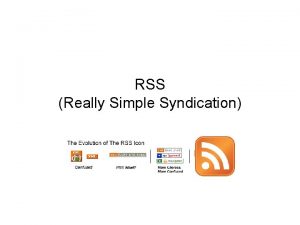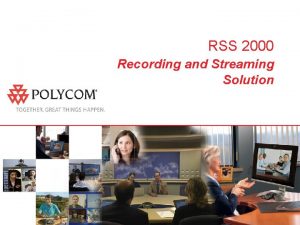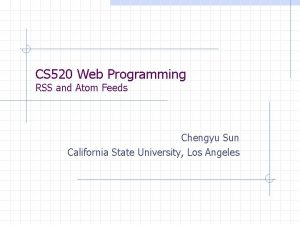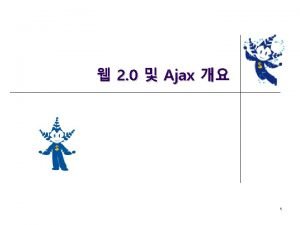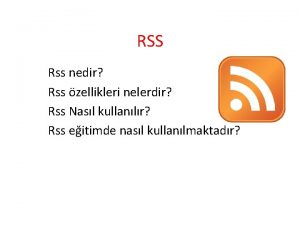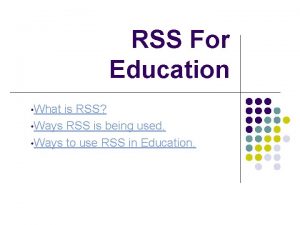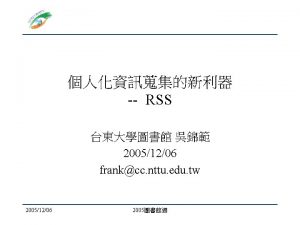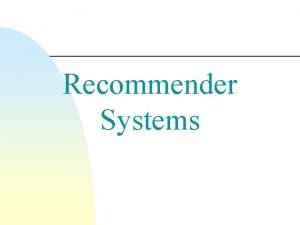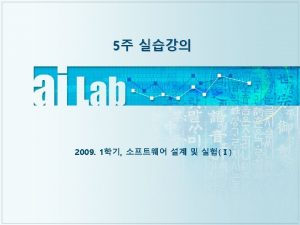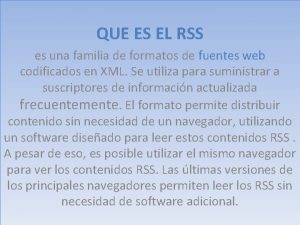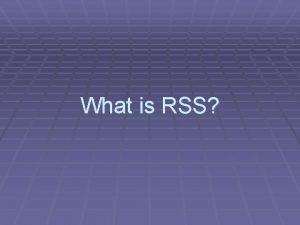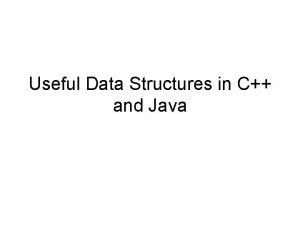Some Useful Engineering Strategies Seth Teller RSS II




















![Linear Separability • Given point sets {Ai}, {Bi}, i in [1. . N] • Linear Separability • Given point sets {Ai}, {Bi}, i in [1. . N] •](https://slidetodoc.com/presentation_image/76c395936d54b90939fd89776ec69012/image-21.jpg)










- Slides: 31

Some Useful Engineering Strategies Seth Teller RSS II 16 November 2005

My Goals Today • Discuss engineering from an intellectual and practical standpoint • Introduce a "toolkit" of ideas and techniques that you can use in your own engineering endeavors • Solicit your own ideas about useful engineering practices

Caveat Auscultator (Listener beware) • Some of this material will be new to you; some will be familiar – It doesn’t hurt to hear things twice. • Some things you will probably agree with; some things you probably won't – But surely you’re used to this by now.

What is Engineering? • Engineering (n. ) (Merriam-Webster Online) – a : the application of science and mathematics by which the properties of matter and the sources of energy in nature are made useful to people – b : the design and manufacture of complex products • Do science, math, usefulness, and complexity “capture” engineering?

What is Engineering? • Engineering (n. ) The process of specifying, designing, implementing, and validating physical artifacts with a desired set of properties (With “properties” construed broadly to mean material attributes, rigid and articulated DOFS, appearance, behavior, …)

Process View • Engineering is a Means … – Specifying: describing what to make – Designing: describing how to make it – Implementing: realizing actual artifact – Validating: convincing yourself (and others) that artifact works as specified • … to an End – Namely: artifact with desired properties

Human View • Engineers are people who: – Conceive of and execute ways to optimize an underspecified tradeoff between possibly conflicting goals • Subject to severe constraints: – Natural: Laws of physics, i. e. , reality – Cultural: Legal system, mores, ethics …

Conception & Execution • Conception: – A mental model of artifact & constraints • Execution: – Putting the mental model into practice – Observing whether it predicts behavior under real-world conditions

Essence of Engineering … • … Process is the (typically iterative) – Formation of a mental model – Implementation of a prototype artifact – Observation of its behavior, leading to: • Revision of designer’s operative mental model • Revision of operative design or implementation • (Or both) • … Until desired behavior is achieved

Visualization & Inspection • Idea: graphical analogue of printf – Visually expose artifact’s internal state ? (CSE Ohio State; CIS 680) • Distinct from “algorithm animation” – Rendering output of batch computation

Consequences • If it “looks wrong” to you, two possibilities: – A) Artifact state really is wrong, in which case: • Artifact has deviated from your mental model • You can find first place of deviation, and fix it – B) Artifact state is correct, in which case: • Your mental model made it “look wrong” to you • Thus your mental model must be revised! A C M K CEabd ab. Cd. E • If it “looks wrong, ” it’s an opportunity to – Improve the system’s behavior, or – Learn something, i. e. , improve mental model!

… And if it looks correct? • Is it correct? • Sure, it often is. But that doesn’t mean that it always is! • Can boil these ideas down to an aphorism: – “Don’t sweep anomalies under the rug. ”

Self-Checking Code • Idea: make machine work for you • For each algorithm/module, write a “checker” that inspects output for the properties that it should have • Convex hull example: – Traverse output vertices in order; check orientation of each triplet • Same idea applies to input – Postconditions (A) == Preconditions (B)

Distinction: Java. Docs • Java. Docs comprise: – Declarations – Comments } for some code corpus • But teammates’ agreement to make the code implement the intent stated in the comments essentially amounts to a social contract

Teammate-Checking Code • Twist: for each module you write, ask a teammate to write checker • Multiple benefits: – Validates your solution (as before) – Decreases chance that checker succeeds due to an invalid assumption (why? ) – Facilitates agreement of your mental model with your teammate’s model – Exploits a natural human characteristic: competitiveness (s/he acts as adversary)

Adversary • Someone/something that tries to – Find holes in your correctness proof (e. g. as A did for R & S of RSA security) – Produce inputs that break your code (e. g. , by violating your assumptions) – Produce conditions that break system (more than just program’s formal input) • Adversary can be a person, program, or even a contrived environment

Adversary’s Strategies • Generate challenging inputs … – Exhaustively – Randomly – Qualitatively – Deviously (e. g. , provoke your teammate to do it) • … and environmental conditions: – Missing or mis-wired connectors – Misbehaving sensors – Depressed all-stop buttons – Undefined environment variables – Misconfigured networks, remote hosts, etc.

Benefiting from Adversary • Implement a “state capture” facility – Ensure that it is very easy to invoke – … And that state can be reconstituted • This makes misbehavior repeatable • Gives rise to “defensive coding” • Aphorism: “Chance favors the prepared program”

Self-Reporting Code • Useful when a subroutine might legitimately succeed or fail – Example: path planning among obstacles • Notion of a “witness” from CS theory community: consists of either a – Checkably correct output solution, or an – Input subset that “proves” infeasibility of the specific input instance provided

Digression: Line Equations • Points represented as p = (x, y, 1) • Lines represented as L = (A, B, C) – Defines “positive halfspace” L. P > 0 – Defines “negative halfspace” L. P < 0 y L 1 p = (1, 1, 1) p = (0, 0, 1) 1 x Example: Line equation x + y = 1 x+y– 1=0 (1, 1, -1). (x, y, 1) = 0 Thus L = (1, 1, -1)
![Linear Separability Given point sets Ai Bi i in 1 N Linear Separability • Given point sets {Ai}, {Bi}, i in [1. . N] •](https://slidetodoc.com/presentation_image/76c395936d54b90939fd89776ec69012/image-21.jpg)
Linear Separability • Given point sets {Ai}, {Bi}, i in [1. . N] • Identify line L s. t. all Ai lie above L, all Bi lie below L, or show no such L exists L Witness to Success Witness to Failure

Caution • Make sure your checking, reporting, witness etc. code has no side effects that enable correct algorithm function • Otherwise, when you remove or suppress self-test, bugs will emerge • Examples?

Self-Test Summary • Pit code against itself. • Aphorism: “Make function prove itself before you trust it. ”

Test Harness • Battery of test cases applied to a system to validate its responses • We’ve seen these in “software only” systems, with “softcopy only” inputs • But what about robotics? How can we validate sensors and actuators using only software? … We can’t!

Robotics is Different! • Robots are subject to “hard state” fundamentally not under s/w control • Consider e. g. all-stop button sense question that arose last week • Or, even harder: sensors. How to force them to behave as you want? • Actuators have same problem • Real world is the only way to enforce absolute consistency of env’t, state

Robotics Test Harness • Place robot in a known environment … so actions have known outcomes • For concreteness, imagine harness for: – Odometry – Motor drivers – Bump sensors – Visual servoing – Arm driver – Brick storage

Self-Test Summary (2) • Pit machine against environment. • Aphorism (Feynman): “You can’t fool Mother Nature. ”

General Comments • You’ve heard it all before – “Think before you code” • My variation on this: – “Validate as you design and implement” • Tangible benefits in rapidity of prototyping & achievable complexity while retaining confidence in correctness

Your Ideas for Next RSS II • How to promote rapid prototyping, validation? • More or better tools? • In-class or in-lab exercises?

Your Ideas for Next RSS II • How to prompt students to address integration, end-to-end issues earlier? – Example: systems group; great idea – Move first integration even earlier? • I. e. , as soon as message formats published?

Summary • Discussed engineering as an endeavor • Described several tools/methods for validation and rapid prototyping • Argued that “robotics is different”
 Seth teller
Seth teller Useful and harmful
Useful and harmful Teller ede vers
Teller ede vers Platt and teller amendments
Platt and teller amendments Teller ede ppt
Teller ede ppt Alle teller lærerveiledning
Alle teller lærerveiledning Endurance synonym
Endurance synonym Flowchart penarikan uang di atm
Flowchart penarikan uang di atm Judy believes that her fate
Judy believes that her fate Ellen teller
Ellen teller Stambreuken en gelijknamige breuken
Stambreuken en gelijknamige breuken Teller bank syariah
Teller bank syariah Nadi normal
Nadi normal Smart teller machine
Smart teller machine Teller ede
Teller ede Deklination junge
Deklination junge Stemmer teller ressurser avgjør
Stemmer teller ressurser avgjør Yahoo weather radar
Yahoo weather radar Rss feed 產生器
Rss feed 產生器 Analisis regresi
Analisis regresi Rss hierarchy
Rss hierarchy Rss adalah
Rss adalah What is rss
What is rss Rss2000
Rss2000 Programming rss feeds
Programming rss feeds Rss w
Rss w Escala de rss
Escala de rss Tweepy.cursor(api.search
Tweepy.cursor(api.search Facebook as rss feed moodle
Facebook as rss feed moodle Classifying some year 2009 strategies
Classifying some year 2009 strategies Sometimes you win some
Sometimes you win some They say it only takes a little faith to move a mountain
They say it only takes a little faith to move a mountain
